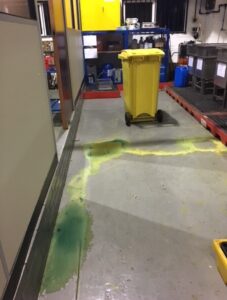Manufacturing is one of many industries that has been privy to the wonders of automation, technology, and artificial intelligence that has seen wonderous improvements in productivity, efficiency and quality.
Having said that, one of its biggest threats to stability is a lack of safety controls and standards. So, safety mustn’t take a back seat.
Manufacturing facilities play a vital role in the UK.
In autumn 2022, the sector accounted for 8.1% of jobs across the whole economy. Its estimated output totals over £180 billion, with the UK being the ninth-largest manufacturing nation worldwide, according to MAKE UK.
However, despite this, the HSE reports that the manufacturing sector saw 22 fatal injuries in 2021/22, out of a total of 123 workers involved in workplace accidents.
While these numbers sound minimal in the scheme of things, the fact remains that any injury or accident is avoidable.
As a manufacturing facility manager, it’s your responsibility to ensure that your employees are working in a safe environment. You also have to ensure that you implement standards and procedures to prevent workplace injury.
The types of manufacturing hazards you can expect to find vary from disruptive to catastrophic and severe.
Workers may encounter numerous hazardous situations as part of their role, but many incidents can be avoided with preparedness, awareness, and peace of mind that support is available.
Types of injuries suffered in manufacturing facilities
- Slips, trips & falls
- Electrical exposure
- Falling objects
- Stress injuries
- Chemical burns or reactions
- Overexertion
- Unsafe Lifting
- Fatigue or dehydration
- Machine-related Accidents
- Vehicle accidents
Many of these hazards often result in production disruption, extended periods off, illness, serious long-term injuries, or even death for employees.
With that in mind, it’s crucial to understand some of the most common safety hazards that exist in manufacturing plants so that you can take steps to prevent them from occurring. So let’s review some of these and provide you with some tips on how to mitigate them.
Common safety hazards in manufacturing
1. Electrical hazards
In a manufacturing facility, electrical hazards can come in numerous forms. Electrical hazards pose a severe risk to products, facilities and personnel, and mismanagement of potential hazards could result in serious injuries like electrocutions or burns, fires, and even death.
Common electrical accidents in manufacturing include direct contact with power lines, poor extension or power cord usage, and poorly maintained power sources. Electrical equipment can gradually falter over time after repeated wear and tear, or it can react when exposed to water sources, or when circuits are overloaded.
Mitigating this risk involves ensuring all electrical equipment is properly installed, configured and insulated.
Install correct ground-fault circuit interrupters and ensure that all electrical tools and equipment are inspected and tested, with any defective products identified and tagged. It’s crucial to ensure that no currents are at risk of being exposed.
There are also plenty of off-the-shelf energy monitors, power analysers and fault line monitors that you can hire to assess your facility’s current performance before committing.
It’s also vital to ensure that all employees, whether full-time or contract, are properly trained in electrical safety and risk management.
2. Chemical hazards
 Many manufacturing facilities use chemical products in several ways. Some are used in industrial product manufacturing, while others are used to clean and maintain workplace premises.
Many manufacturing facilities use chemical products in several ways. Some are used in industrial product manufacturing, while others are used to clean and maintain workplace premises.
Industrial manufacturing facilities are notorious for using poisonous or highly corrosive chemicals, which can cause severe and sometimes irreparable damage. Workers may have to work with chemicals like caustic cleaners, flammable substances like ethanol, and even products containing bleach.
Therefore, chemicals must be treated with caution. Facilities managers must provide sufficient personal protective equipment (PPE) for employees that are required to use any chemicals and ensure that all staff are sufficiently trained in categorising and handling them, as well as treating any wounds suffered.
3. Vehicular hazards
Powered industrial machines are commonly found in manufacturing facilities. These machines and vehicles include forklifts, lift and reach trucks, and extend to include vehicles in fleets.
Within a facility, however, personnel will use these machines to raise, lower, or move goods and materials, typically in large quantities.
The injuries caused by these vehicles and machines can range from minor to severe, with the root cause predominantly being improper or insufficient training.
These types of vehicles should only be operated by those with valid certifications and training, such as a forklift license training course. Typically speaking, workers will only be able to operate certain machinery once an official qualification can be obtained.
Facility managers should provide regular, ongoing training for anyone responsible for operating machinery. Supervisors should oversee employees operating these vehicles constantly, in accordance with a defined schedule of operation. The machinery should be regularly inspected, tested, and maintained for any emerging mechanical failures.
4. Machine guarding
Manufacturing facilities are required to use certain types of heavy machinery and equipment, such as guillotines, shears, radial drills, and so on.
These types of machines will typically produce protruding sparks, chips and highly dangerous rotating parts that could result in severe damage to body parts, possibly even amputation or even death.
It’s not uncommon to find workers becoming complacent when operating machinery day after day, and doing so could further their risk of severe injury.
This is where solid machine guarding barriers can come in handy. With effective machine guarding, imminent safety risks are mitigated, with guards providing a solid protective barrier for workers that are in close proximity to machines.
Management should always ensure this machinery is inspected for maximum operational efficiency, but also ensure all workers are up to speed with correct procedures for safe operation.
5. Poor maintenance
 Overlooking equipment and machinery maintenance drastically increases the risk of workplace hazards and injuries. For instance, the HSE found that over the last few years, 25-30% of Manufacturing fatalities in the UK related to maintenance activity.
Overlooking equipment and machinery maintenance drastically increases the risk of workplace hazards and injuries. For instance, the HSE found that over the last few years, 25-30% of Manufacturing fatalities in the UK related to maintenance activity.
Some machinery, even if they are classed as failsafe, can malfunction. Therefore, even if correct steps have been followed in preparation and operation, further risks could be present if the equipment suddenly develops a fault that was previously unaccounted for.
This is why managers must ensure that professional third parties regularly conduct maintenance checks on all types of equipment.
All employees must be trained in operating, maintaining and handling this equipment in the event of an emergency breakdown, with all warning indications clearly identifiable. Put simply, poor maintenance can have a significant knock-on effect.
Clear priorities
It can be easy to baulk at the need for stringent, rigorous and firm safety procedures and precautions. They may seem draconian on the surface, however, cutting corners and ignoring safety warnings can spell disaster.
It’s clear from the above that safety hazards continue to pose a serious issue to employers and workers who, unbeknownst to many, put their lives on the line by undertaking dangerous activities.
Employee health and safety is and should always be a manufacturing facility manager’s number one priority. Hazard identification, control, guarding, and regular training go a long way in improving individual and collective safety across manufacturing facilities.
Original article: Five common safety hazards in manufacturing facilities (shponline.co.uk)

